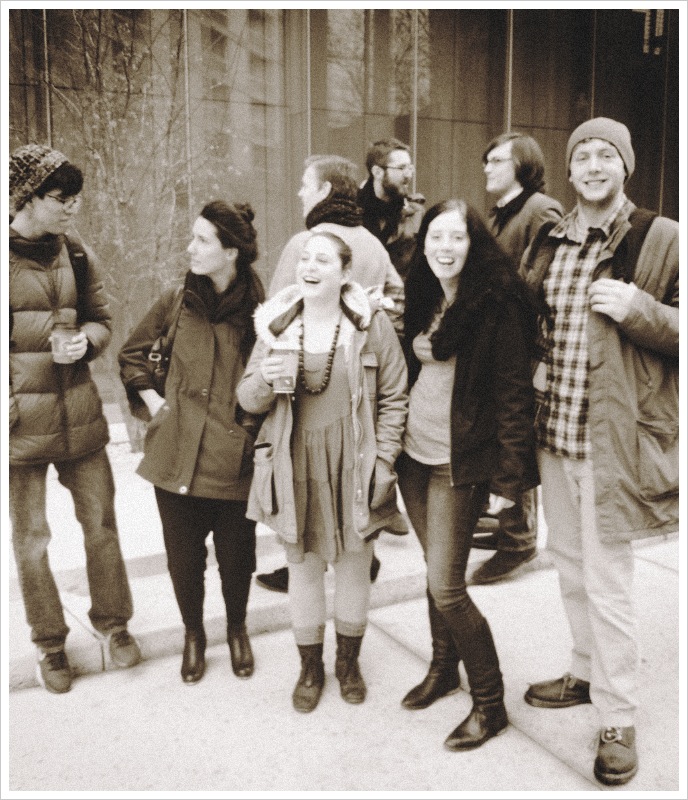
CPR VISITS THE POFO
[flickr id=”11224068265″ thumbnail=”medium” overlay=”true” size=”original” group=”” align=”none”]
I always tell prospective MFA students that one of the best things about our program—aside from reading each other’s work or writing collaborative poems over a PB&J after class—is the chance to be an editor for Columbia Poetry Review. Hands down. This is where we learn the bones of magazine production, editing, submission processes, reviews, and maybe even more importantly, how to avoid the pitfalls in our own writing that keep good poems from becoming great ones.
Each week we meet for Columbia Poetry Review (CPR) to discuss batches of submissions in small groups composed of both editors and editorial board members, then engage in a larger discussion what poems we think are necessary for the current issue. Although there is a style and stance of CPR in general, each issue, ultimately, is a reflection of the current editors’ own aesthetics and preferences. And although a clear consensus is usually reached, it is not uncommon for an editor’s selection to be challenged by another editor. This kind of call and checking forces us as readers and editors to speak both urgently and meaningfully about the poems, often in a way that carries much greater responsibility than the way we might talk about poems in workshop.
It is not uncommon for these critical discussions about various submissions to continue outside of the classroom, as the critical engagement goes way beyond the allotted 12:30-3:20pm time slot. That’s when we know that the poetry is real and at work in our lives.
[flickr id=”11224018956″ thumbnail=”medium” overlay=”true” size=”original” group=”” align=”none”]
Last Tuesday, however, we took a break from the boardroom, as the editorial staff of Poetry Magazine had invited our group from CPR to the Poetry Foundation. After gathering outside the foundation’s stunning façade, we were met by Poetry Magazine’s Editorial Assistant and MFA Poetry alum Holly Amos, who gave us a tour of the foundation’s current art exhibition, libraries, and performance space. As indicated by some of the ephemera of Emily Dickinson in the November issue, the latest exhibition is a presentation of her marginalia as well as work from contemporary artists engaging in dialogue with Dickinson and her work.
[flickr id=”11223996985″ thumbnail=”medium_640″ overlay=”true” size=”original” group=”” align=”none”]
[flickr id=”11224455673″ thumbnail=”medium” overlay=”true” size=”original” group=”” align=”none”]
[flickr id=”11224104583″ thumbnail=”medium_640″ overlay=”true” size=”original” group=”” align=”none”]
The library consists of over 30,000 volumes (cha-ching!) and is open to the public Monday through Friday, 11am-4pm. In addition to the main library of both single author and anthology collections, there is a formidable chapbook collection and a children’s library.
Speaking of children’s poetry, I received a text message from a dear friend later that night:
[flickr id=”11223993795″ thumbnail=”medium_640″ overlay=”true” size=”original” group=”” align=”none”]
But seriously, the PoFo chapbook collection will make you flip.
We then met in the performance space with Editors Don Share and Lindsay Garbutt, who answered questions about managing submissions, solicitations, digital formatting, the whole nine yards. They brought water down with them, and it wasn’t bottled, which was a surprise. And I think the glasses even came from IKEA, but it was hard to say.
[flickr id=”11224003754″ thumbnail=”medium_640″ overlay=”true” size=”original” group=”” align=”none”]
When I asked Don if it was even possible to manage keeping up with the world of contemporary poetry—as multiplicitious and ever-evolving, in both form and dissemination, as it is—he simply asked if any of us would go see a doctor who “couldn’t keep up.” I thought, okay, fiiiiine, even though he is the editor of Poetry Magazine and the rest of us are working three jobs during grad school. But the point is still the same. If we’re going to succeed in the world of poetry and publishing, it takes being hungry, being engaged, and doing a whole lot of “fancy dancing” to keep getting things done on time. And frankly, there’s no more exciting way to spend my time in graduate school than to be completely wrapped up in everything I’m doing.
Next week when the semester’s final classes are over, the CPR editors will meet for a marathon potluck and sequencing session to arrange the order of Issue 27. One of my highlights from last year was sitting in with the editors of Issue 26 while they sequenced their issue. It is a tremendous feeling of accomplishment, pride, and downright giddiness to see the year’s crazed labor come together in a beautiful and necessary collection of contemporary poetry.
